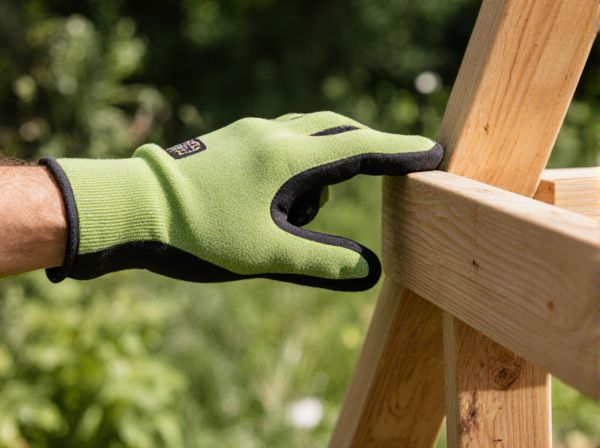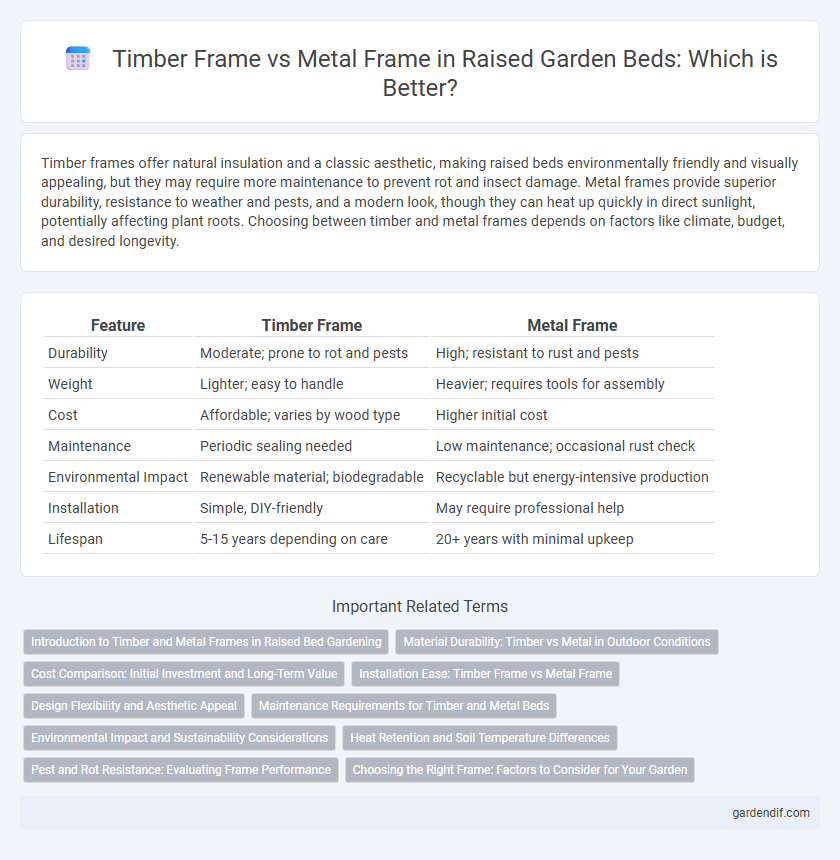
Timber frame vs Metal frame Illustration
Timber frames offer natural insulation and a classic aesthetic, making raised beds environmentally friendly and visually appealing, but they may require more maintenance to prevent rot and insect damage. Metal frames provide superior durability, resistance to weather and pests, and a modern look, though they can heat up quickly in direct sunlight, potentially affecting plant roots. Choosing between timber and metal frames depends on factors like climate, budget, and desired longevity.
Table of Comparison
| Feature | Timber Frame | Metal Frame |
|---|---|---|
| Durability | Moderate; prone to rot and pests | High; resistant to rust and pests |
| Weight | Lighter; easy to handle | Heavier; requires tools for assembly |
| Cost | Affordable; varies by wood type | Higher initial cost |
| Maintenance | Periodic sealing needed | Low maintenance; occasional rust check |
| Environmental Impact | Renewable material; biodegradable | Recyclable but energy-intensive production |
| Installation | Simple, DIY-friendly | May require professional help |
| Lifespan | 5-15 years depending on care | 20+ years with minimal upkeep |
Introduction to Timber and Metal Frames in Raised Bed Gardening
Timber frames in raised bed gardening offer natural insulation and a traditional aesthetic, promoting healthy soil temperature and moisture retention. Metal frames provide durability, resistance to rot and pests, and a modern, sleek look, ideal for long-term use and structural stability. Choosing between timber and metal depends on priorities such as environmental impact, maintenance needs, and design preferences in raised bed construction.
Material Durability: Timber vs Metal in Outdoor Conditions
Timber frames offer natural resistance to outdoor conditions but require regular treatment to prevent rot, insect damage, and weathering, affecting their long-term durability. Metal frames, particularly those made from galvanized steel or aluminum, provide superior resistance to rust, corrosion, and structural degradation, ensuring a longer lifespan in harsh climates. Choosing between timber and metal depends on balancing aesthetic preference with maintenance commitment and environmental exposure.
Cost Comparison: Initial Investment and Long-Term Value
Timber frames for raised beds typically require a lower initial investment, with prices ranging from $20 to $60 per unit, depending on the wood quality, but they may need replacement or treatment every 3 to 5 years due to rot. Metal frames cost more upfront, often between $50 and $150, yet offer superior longevity and resistance to weather, providing better long-term value by reducing maintenance and replacement expenses. When comparing cost efficiency, timber is budget-friendly initially, while metal frames deliver higher durability and overall savings over time.
Installation Ease: Timber Frame vs Metal Frame
Timber frames for raised beds offer straightforward installation due to their lightweight nature and ability to be cut and assembled with basic tools. Metal frames, although sturdier, often require specialized tools and hardware, making installation more complex and time-consuming. Home gardeners typically find timber frames more accessible, while metal frames suit those with experience or seeking durability.
Design Flexibility and Aesthetic Appeal
Timber frame raised beds offer greater design flexibility due to their ease of customization, allowing for intricate shapes, various finishes, and natural textures that enhance garden aesthetics. Metal frame raised beds provide a sleek, modern look with durable, clean lines but often lack the warmth and organic appeal of timber. While metal frames excel in longevity and low maintenance, timber frames dominate in versatility and visual integration with natural landscapes.
Maintenance Requirements for Timber and Metal Beds
Timber frame raised beds require periodic sealing or staining to prevent rot, insect damage, and weathering, ensuring longevity in outdoor conditions. Metal frame raised beds are low-maintenance, resistant to rust and corrosion when constructed from galvanized steel or aluminum, requiring only occasional cleaning to maintain their appearance. Both materials benefit from proper installation and drainage to minimize structural wear and extend the lifespan of the raised bed garden.
Environmental Impact and Sustainability Considerations
Timber frame raised beds offer a renewable, biodegradable option with a lower carbon footprint due to carbon sequestration during tree growth, making them highly sustainable when sourced from responsibly managed forests. Metal frame raised beds, while durable and often recyclable, involve energy-intensive production processes that contribute to higher greenhouse gas emissions and resource depletion. Choosing sustainably harvested wood or recycled metal materials can significantly reduce environmental impact, aligning with eco-friendly gardening practices.
Heat Retention and Soil Temperature Differences
Timber frames in raised beds provide superior heat retention due to wood's natural insulating properties, helping maintain stable soil temperatures crucial for plant growth. Metal frames, while durable, conduct heat rapidly, causing greater soil temperature fluctuations that can stress roots and hinder nutrient absorption. Choosing timber over metal enhances thermal stability, promoting healthier plant development and extended growing seasons.
Pest and Rot Resistance: Evaluating Frame Performance
Timber frames in raised beds can suffer from rot and pest infestations if not properly treated or sealed, leading to reduced durability over time. Metal frames offer superior resistance to pests and rot, as they do not absorb moisture or provide a habitat for insects, ensuring longer structural integrity. Choosing metal frames enhances raised bed longevity by minimizing maintenance and protecting plant roots from harmful pests.
Choosing the Right Frame: Factors to Consider for Your Garden
Timber frames for raised beds offer natural durability and aesthetic appeal, ideal for gardens prioritizing organic materials, while metal frames provide superior strength and resistance to pests and rot, making them suitable for long-term use and modern garden designs. Consider factors such as climate exposure, maintenance requirements, and budget when selecting between timber and metal frames to ensure optimal longevity and performance. Evaluating the environmental impact and ease of installation can further guide your choice to match your garden's specific needs.
Timber frame vs Metal frame Infographic

 gardendif.com
gardendif.com